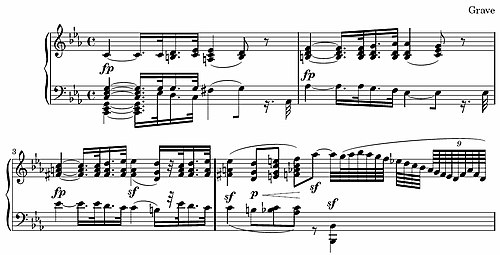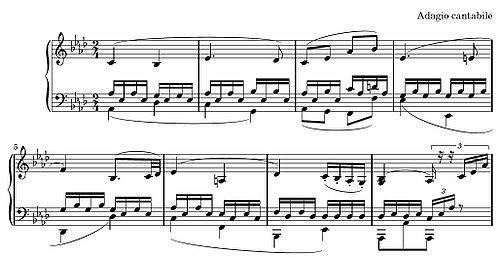Piano Sonata No. 8 (Beethoven): Difference between revisions
| Line 14: | Line 14: | ||
===Grave - Allegro di molto e con brio=== |
===Grave - Allegro di molto e con brio=== |
||
The first movement is in [[sonata form]]. It includes a slow introductory theme, written in ''Grave'', that is reminiscent of the [[Baroque music| Baroque period]], specifically [[Johann Sebastian Bach|Bach]]'s [[Partita]] No. 2 in C minor.{{Fact|date=November 2007}} This first theme begins at the start of the ''Allegro'' section. This main section is in 2/2 time in the home key of [[C minor]], modulating, like most [[minor (music)|minor-key]] sonatas of this period, to the [[mediant]], [[E flat]] - however Beethoven makes use of unorthodox mode-mixture, as he presents the second subject in [[e-flat minor]] rather than the customary [[major (music)| |
The first movement is in [[sonata form]]. It includes a slow introductory theme, written in ''Grave'', that is reminiscent of the [[Baroque music| Baroque period]], specifically [[Johann Sebastian Bach|Bach]]'s [[Partita]] No. 2 in C minor.{{Fact|date=November 2007}} This first theme begins at the start of the ''Allegro'' section. This main section is in 2/2 time in the home key of [[C minor]], modulating, like most [[minor (music)|minor-key]] sonatas of this period, to the [[mediant]], [[E flat]] - however Beethoven makes use of unorthodox mode-mixture, as he presents the second subject in [[e-flat minor]] rather than the customary [[major (music)|major-key]]. The return of the slow theme may have been inspired by [[Joseph Haydn]]'s [[Symphony No. 103 (Haydn)|"Drumroll" Symphony]], completed three years earlier in 1795.{{Fact|date=November 2007}} Beethoven extends Haydn's compositional practice by returning to the introductory material, not once but twice - at the beginning of the development section as well as in the [[coda (music)| coda]]. |
||
Interestingly, Beethoven does not specify where the first movement's repeat should begin. Traditionally, most pianists start their repeat at the beginning ''Allegro'', but some choose to start from the beginning of the piece (''Grave''). This latter option also makes musical sense as Beethoven begins his Development with the slow theme. {{Fact|date=February 2008}} |
Interestingly, Beethoven does not specify where the first movement's repeat should begin. Traditionally, most pianists start their repeat at the beginning ''Allegro'', but some choose to start from the beginning of the piece (''Grave''). This latter option also makes musical sense as Beethoven begins his Development with the slow theme. {{Fact|date=February 2008}} |
||
Revision as of 05:42, 15 March 2008
Ludwig van Beethoven's Piano Sonata No. 8 in C minor, op. 13, commonly known as Pathétique, was published in 1799, though written the year before, when the composer was 27 years old. Beethoven dedicated the work to his friend Prince Karl von Lichnowsky. Although commonly thought to be one of the few works to be named by the composer himself, it was actually named by the publisher, to Beethoven's liking [1]
The Pathétique Sonata is perhaps the earliest of Beethoven's compositions to achieve widespread and enduring popularity. It is widely represented on the concert programs and recordings of professional pianists [citation needed]. As one of the more famous Beethoven pieces, it has been incorporated into several works of popular culture [citation needed].
In its entirety, encompassing all three movements, the work takes approximately 19 minutes to perform.
Movements
The sonata is comprised of three movements:
- Grave (Very slowly, with solemnity) - Allegro di molto e con brio (Quickly, with much vigor)
- Adagio cantabile (Slowly, in a singing style)
- Rondo: Allegro (Quickly)
Grave - Allegro di molto e con brio
The first movement is in sonata form. It includes a slow introductory theme, written in Grave, that is reminiscent of the Baroque period, specifically Bach's Partita No. 2 in C minor.[citation needed] This first theme begins at the start of the Allegro section. This main section is in 2/2 time in the home key of C minor, modulating, like most minor-key sonatas of this period, to the mediant, E flat - however Beethoven makes use of unorthodox mode-mixture, as he presents the second subject in e-flat minor rather than the customary major-key. The return of the slow theme may have been inspired by Joseph Haydn's "Drumroll" Symphony, completed three years earlier in 1795.[citation needed] Beethoven extends Haydn's compositional practice by returning to the introductory material, not once but twice - at the beginning of the development section as well as in the coda.
Interestingly, Beethoven does not specify where the first movement's repeat should begin. Traditionally, most pianists start their repeat at the beginning Allegro, but some choose to start from the beginning of the piece (Grave). This latter option also makes musical sense as Beethoven begins his Development with the slow theme. [citation needed]

Musicologist Donald Francis Tovey suggests leaving out the repeat altogether[2] , and some performers follow this practice.[citation needed]
Adagio cantabile
The Adagio movement opens with the famous cantabile ("in a singing style") melody. This theme is played three times, interspersed with two modulating episodes: the first going from F minor to E flat major, the second from A flat minor to E major. With the final return of the main theme, the accompaniment becomes richer and takes on the triplet rhythm of the second episode. The brief coda's stylistic diversity is arresting: four bars of Romantic transcendence followed by a strikingly conventional 18th-century close.

Another interesting feature of the Adagio is its range in texture. After having a thick four-voice texture in the principal theme, Beethoven temporarily reduces the texture to one voice near the closing of the B section. The same kind of textural reduction takes place in the opening and last measures of the coda.
Rondo: Allegro
The sonata closes with a 2/2 movement in C minor. The main theme strongly resembles the second theme of the Allegro of the first movement, being identical to it in its pitch pattern for the first four notes and in its rhythmic pattern for the first eight. It follows a version of sonata rondo form that includes a coda; see Sonata rondo#Codas for this structure. The three rondo episodes are in E flat, A flat, and C major. The common use of sforzandos create a forceful effect, although overall the rondo is relatively lightweight compared to the first movement.
Beethoven's notes show that he originally planned the movement as a rondo for piano accompanied by another instrument, perhaps a violin.[citation needed]
Notes
- ^ Burkhart, Charles: "Anthology for Musical Analysis", page 233. Schirmer 2004.
- ^ Tovey, Donald Francis. Beethoven - Sonata in C minor for piano - Op.13 'Pathetique'. ABRSM Publishing. ISBN 1-85472-015-5.
{{cite book}}: Cite has empty unknown parameter:|1=(help); Unknown parameter|coauthors=ignored (|author=suggested) (help)
Media
Template:Multi-listen start Template:Multi-listen item Template:Multi-listen end
See also
External links
- The William and Gayle Cook Music Library at the Indiana University School of Music has posted a scan of the Ricordi edition of the score.
- A public domain engraving of the score using GNU LilyPond and MIDI files are available from the Mutopia Project in several formats.
- Brief analysis of the Pathétique Sonata and free score on the All About Ludwig van Beethoven Pages.
- A YouTube video of this sonata played by Freddy Kempff.
- Free scores by Piano Sonata No. 8 (Beethoven) at the International Music Score Library Project (IMSLP)
